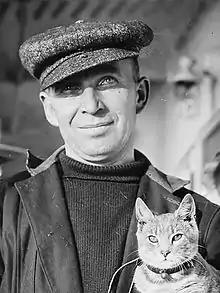Melvin Vaniman
Chester Melvin Vaniman (October 30, 1866 – July 2, 1912) was an American aviator and photographer who specialized in panoramic images. He shot images from gas balloons, ships masts, tall buildings and even a home-made 30-metre (98 ft) pole. He scaled buildings, hung from self-made slings, and scaled dangerous heights to capture his unique images.
Melvin Vaniman | |
|---|---|
 Vaniman and cat "Kiddo" | |
| Born | Chester Melvin Vaniman October 30, 1866 Virden, Illinois, U.S. |
| Died | July 2, 1912 (aged 45) off Atlantic City, New Jersey, U.S. |
| Alma mater | Valparaiso University |
| Occupation | Aviator, photographer |
Early life
Born to a farming family in Virden, Illinois, Vaniman was the eldest of four sons and attended Valparaiso University in Indiana and Chicago.
Career
Photography
Vaniman's photographic career began in Hawaii in 1901, and ended some time in 1904. He spent over a year photographing Australia and New Zealand on behalf of the Oceanic Steamship Company, creating promotional images for the company. During this time the New Zealand Government also commissioned some panoramic images.
Beginning in 1903, he spent over a year photographing Sydney and the surrounding areas. It was during this time that he created his best known work, the panorama of Sydney, shot from a hot air balloon he had specially imported from the United States. Vaniman is best known for his images of Hawaii, Australia, and New Zealand.
Aerial exploration

Some time around 1904, he gave up photography and took up exploration. This included attempts at the North Pole and the Trans-Atlantic crossing – both attempted in Walter Wellman's airship America.
At the first attempt to cross the Atlantic in 1910, Vaniman sent one of the first aerial radio transmissions when he urged the launch boat to "come and get this goddamn cat!" The cat, named Kiddo, had caused such a ruckus that it finally had to be placed inside a gunny sack and suspended below the airship's gondola.[1][2][3]
They anticipated a five-day crossing, but the airship's motor failed after 38 hours, leaving it adrift until it was rescued two days later by the SS Trent, a passing Royal Mail steamship.[4][5]
Death
Vaniman lost his life during his second attempt at a trans-Atlantic airship crossing when his airship, the Goodyear built Akron, (not the later US Navy airship of the same name) exploded off the New Jersey shore on July 2, 1912.[6] Filled with 11,300 cubic meters of hydrogen gas, his was the first American airship that could compare to the better known European manufactured models.[7]
Vaniman and his crew of four were killed just a few minutes after the Akron became airborne, when it suddenly exploded in front of the gathered crowd near Atlantic City, and the burning gondola plunged 750 metres (2,461 ft) into an inlet. The other victims were his brother, Calvin Vaniman, Fred Elmer, George Bourtillion, and Walter Guest. Subsequent investigation indicated that internal pressure had ruptured the envelope.[8]
References
- "Kiddo, the airship cat" Purr'n'Fur
- "“Roy, come and get this goddamn cat” was the first ever in-flight radio transmission"
- Copping, Jasper. "America the airship: the first transatlantic crossing" The Daily Telegraph, 13 October 2010. Accessed: 1 November 2014.
- Trevelyan, Laura (October 15, 2010). "Airship America's landmark crossing attempt recalled". BBC News. Retrieved October 15, 2010.
- Davies, Alan. "Vaniman, the acrobatic photographer". State Library of New South Wales 2007. Archived from the original on September 4, 2007.
enlarged again to 9760 cubic metres volume, giving a lifting capacity of 12 tonnes ... launched on 15 October 1910 ... crew of six, including Wellman and Vaniman and a stowaway cat
- "Seiberling-Vaniman Goodyear airship Akron – 1911". Rosebud's WWI and Early Aviation Image Archive. Archived from the original on November 19, 2008. Retrieved November 30, 2016.
- "The Vaniman Balloon" Popular Mechancs, December 1911, p. 810.
- Dilks, John. What Happened After the Rescue? QST, January 2011, pp. 95–96.
External links
- Works by or about Melvin Vaniman in libraries (WorldCat catalog)